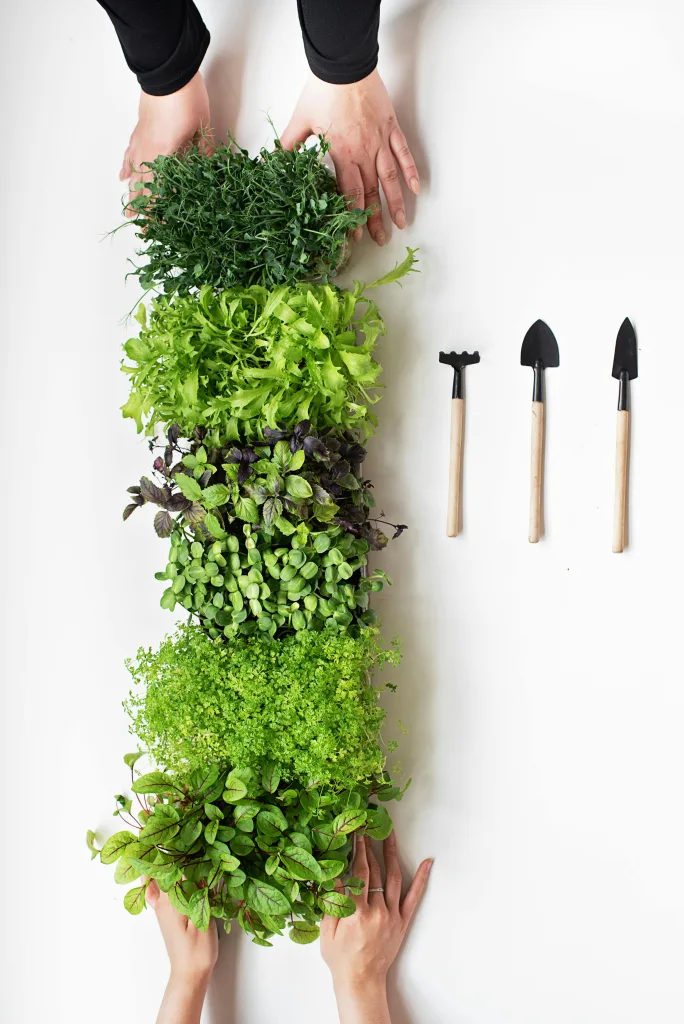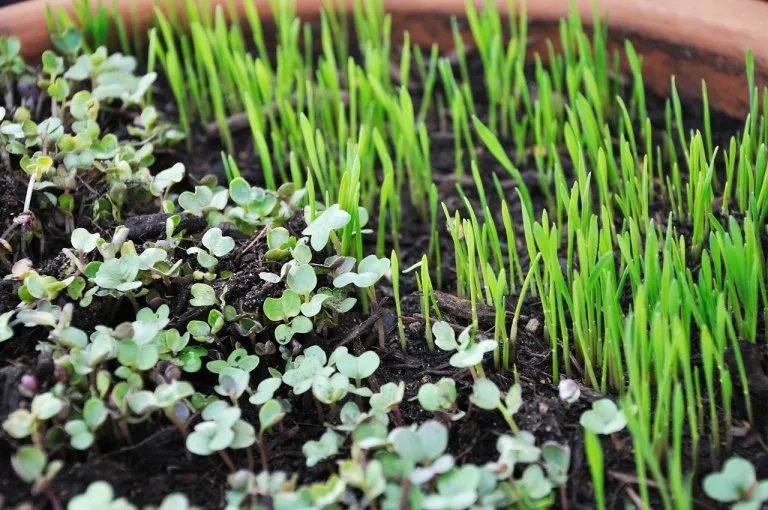Microgreens are not only for restaurants anymore; they have become a new obsession and a great addition to everyone’s cooking. I love adding Alfalfa to my baked beans or sweet and fresh pea microgreens to my salad soups.
Let’s have a look at microgreens. Are they that much better than the grown version of the greens? Let’s explore microgreens’ benefits and nutrition, how to grow microgreens at home, and how to store and eat them.
WHAT ARE MICROGREENS?
Microgreens are young, edible seedlings of vegetables and herbs that are harvested just after the first true leaves have developed. They are more mature than sprouts but younger than baby greens. Typically, microgreens are harvested 7-21 days after germination.
Recently, microgreens have gained popularity due to their impressive nutritional profile and potential health benefits.
MICROGREENS BENEFITS:
Microgreens are a nutrient-dense food with significant health benefits, including antioxidants, cardiovascular health support, anti-inflammatory and anti-ageing (1), disease prevention, cognitive protection, and improved digestion(2).
WHY ARE MICROGREENS SO NUTRITIOUS?
Microgreens often contain higher concentrations of vitamins, minerals, and antioxidants than mature plants. Here are some reasons why:
- Early Growth Stage: During the early stage, plants allocate many nutrients to their young shoots to support rapid growth. These nutrients are concentrated in the microgreens, making them particularly rich in vitamins and minerals.
- Photosynthesis: Young plants are very active in photosynthesis, which increases the production of vitamins.
- Easier Absorption: Microgreens’ nutrients are more bioavailable, making them more accessible for the body to absorb and use. This is because microgreens have fewer fibres and cell walls to break down compared to mature plants.
- Growth Conditions: Microgreens are usually grown in optimal conditions with sufficient light, water, and nutrients, accumulating large amounts of nutrients in the young plants.
- Short Growth Cycle: The short growth cycle means the nutrients are concentrated in the small leaves and stems.
14 POPULAR MICROGREENS NUTRIENTS, VITAMINS & MINERALS
Some microgreens are very affordable and readily available, while others are more challenging to get hold of and are pretty expensive. Let’s compare the most popular 14 microgreens:
- Fenugreek microgreens
- Pea microgreens
- Sunflower microgreens
- Lentil microgreens
- Mug bean microgreens
- Broccoli microgreens
- Alfalfa microgreens
- Mustard microgreens
- Chickpea microgreens
- Chia seed microgreens
- Wasabi microgreens
- Carrot microgreens
- Quinoa microgreens
- Basil microgreens

Here is a table for us to compare the nutrients each microgreen has in this Microgreens nutrition chart summarizing the key nutritional components for each type of microgreen. This comparison includes nutrients such as vitamins (A, C, K), minerals (calcium, iron, magnesium), and antioxidants.
| Microgreen | Vitamins (A, C, E, K) | Minerals (Calcium, Iron, Magnesium) | Antioxidants and Other Nutrients |
|---|---|---|---|
| Fenugreek | A, C | Calcium, Iron, Magnesium | Rich in fiber, phytoestrogens |
| Pea | A, C, K | Calcium, Iron, Magnesium | High in protein, folate, and chlorophyll |
| Sunflower | A, C, E | Calcium, Iron, Magnesium | High in protein, rich in folic acid, essential fatty acids |
| Lentil | A, C | Calcium, Iron, Magnesium | High in protein, folate, rich in fiber |
| Mung Bean | A, C | Calcium, Iron, Magnesium | High in protein, folate, antioxidants |
| Broccoli | A, C, K | Calcium, Iron, Magnesium | High in sulforaphane, glucoraphanin |
| Alfalfa | A, C, K | Calcium, Iron, Magnesium | High in saponins, phytoestrogens |
| Mustard | A, C, K | Calcium, Iron, Magnesium | Rich in glucosinolates, antioxidants |
| Chickpea | A, C | Calcium, Iron, Magnesium | High in protein, fiber, folate |
| Chia Seed | A, C, K | Calcium, Iron, Magnesium | High in omega-3 fatty acids, antioxidants |
| Wasabi | A, C | Calcium, Iron, Magnesium | Rich in isothiocyanates, antioxidants |
| Carrot | A, C, K | Calcium, Iron, Magnesium | High in beta-carotene, antioxidants |
| Quinoa | A, C | Calcium, Iron, Magnesium | High in protein, fiber, lysine |
| Basil | A, C, K | Calcium, Iron, Magnesium | Rich in eugenol, antioxidants, anti-inflammatory compounds |
Let’s look in more detail to see if certain microgreens’ nutrients are more substantial. To see which microgreen is rich in what nutrient or mineral (you can use the arrows in the table to sort).
Nutritional Comparison of Microgreens per 100 grams:
| Microgreen | Vitamin A (µg) | Vitamin C (mg) | Vitamin K (µg) | Calcium (mg) | Iron (mg) | Magnesium (mg) | Protein (g) | Fiber (g) | Notable Antioxidants and Nutrients |
|---|---|---|---|---|---|---|---|---|---|
| Fenugreek | 1080 | 33 | 41.9 | 58 | 1.16 | 54 | 4.9 | 1.7 | Phytoestrogens, fiber |
| Pea | 339 | 22.4 | 42.3 | 39 | 2.14 | 33 | 3.6 | 2 | Folate, chlorophyll, protein |
| Sunflower | 18 | 25 | 62 | 70 | 2.5 | 51 | 2.3 | 1.2 | Folic acid, essential fatty acids, protein |
| Lentil | 94 | 25 | 33.7 | 25 | 2.92 | 47 | 8.9 | 1.4 | Folate, protein, fiber |
| Mung Bean | 43 | 13.2 | 31.1 | 21 | 2.09 | 31 | 3 | 1.8 | Folate, antioxidants, protein |
| Broccoli | 160 | 89.2 | 101.6 | 48 | 0.66 | 21 | 2.8 | 3.8 | Sulforaphane, glucoraphanin |
| Alfalfa | 42 | 8.2 | 30.5 | 32 | 0.96 | 27 | 3.8 | 1.9 | Saponins, phytoestrogens |
| Mustard | 80 | 70 | 257.5 | 39 | 2.7 | 38 | 4 | 1.8 | Glucosinolates, antioxidants |
| Chickpea | 67 | 6 | 43 | 25 | 2.89 | 48 | 8.9 | 2.2 | Protein, fiber, folate |
| Chia Seed | 54 | 6.7 | 148 | 92 | 7.7 | 58 | 4 | 2.3 | Omega-3 fatty acids, antioxidants |
| Wasabi | 80 | 41.5 | 16.9 | 34 | 2.3 | 42 | 3.4 | 1.4 | Isothiocyanates, antioxidants |
| Carrot | 15850 | 5.9 | 13.2 | 37 | 1.24 | 21 | 0.6 | 1.5 | Beta-carotene, antioxidants |
| Quinoa | 14 | 5.6 | 8.5 | 32 | 4.57 | 34 | 4.4 | 3.8 | Protein, fiber, lysine |
| Basil | 5276 | 18 | 414.8 | 177 | 3.2 | 64 | 3.2 | 1.6 | Eugenol, antioxidants, anti-inflammatory compounds |
Please note that the values are based on averages and may vary slightly depending on growing conditions and other factors.
After analysing the table, here are the main findings of the most nutritious microgreens:
- Fenugreek Microgreens: Rich in fibre and phytoestrogens. Phytoestrogens can help alleviate menopausal symptoms, improve bone and cardiovascular health, reduce the risk of certain cancers, balance hormones, and support skin health(3).
- Pea Microgreens: High in protein and folate, also known as vitamin B9, essential for blood health and reducing cardiovascular disease risk (4).
- Sunflower Microgreens: Rich in essential fatty acids and folic acid.
- Lentil Microgreens: High in protein and fibre.
- Mung Bean Microgreens: Great source of antioxidants.
- Broccoli Microgreens: Contain sulforaphane, which has antioxidative and anti-inflammatory properties and cancer-fighting benefits (5).
- Alfalfa Microgreens: High in phytoestrogens and saponins, which help lower cholesterol.
- Mustard Microgreens: Rich in glucosinolates, which support detoxification.
- Chickpea Microgreens: High in protein and fibre, support muscle growth and digestion.
- Chia Seed Microgreens: Rich in omega-3 fatty acids and supports heart health.
- Wasabi Microgreens: Contain isothiocyanates, powerful antioxidants (6).
- Carrot Microgreens: High in beta-carotene, good for eye health.
- Quinoa Microgreens: High in protein and lysine, they support tissue repair.
- Basil Microgreens: Contains eugenol, which helps with inflammation.
HOW DO MICROGREENS COMPARE NUTRITIONALY TO GROWN PLANTS?
Research has shown that microgreens can have nutrient levels up to 40 times higher than mature plants:
- Vitamin C: Up to 6 times higher in microgreens.
- Beta-carotene: Up to 40 times higher in some varieties.
- Vitamin E: Significantly higher concentrations in microgreens.
- Vitamin K: Higher levels in microgreens.
Microgreens generally have higher concentrations of specific vitamins (like Vitamins A and K) and minerals (like Iron) than their mature plant counterparts. However, some nutrients, such as fibre and protein, might be higher in mature plants.
You can also read an article 20 AFFORDABLE SUPERFOODS & THEIR SCIENCE-PROVED BENEFITS

GROWING MICROGREENS AT HOME
I normally buy microgreens in a farmer’s market as they are so fresh. I go for broccoli, pea, or radish and the seller cuts them fresh for me. If there is no farmers market around, I also buy microgreens like sunflower and Alfalfa in supermarkets or organic shops.
If you can’t get hold of microgreens or find them too expensive, here is a quick guide on how to grow microgreens at home.
Things you will need:
- Seeds: Choose seeds specifically labelled for microgreens to ensure high germination rates. For better nutrition, choose organic, non-GMO seeds.
- Growing Tray: An ideal growing tray is a shallow tray with drainage holes. You can use a seedling tray or a repurposed shallow container.
- Growing Medium: Use soil, coconut coir, or a special microgreen mat.
- Water Spray Bottle: For gentle watering, try getting a mist bottle that sprays water very gently.
- Light: Natural sunlight or a grow light.
- OPTIONAL, Plastic Dome or Cover: to create a greenhouse effect and maintain moisture during germination.
There are a few nice options on Amazon, where you can buy a whole kit. Just read the reviews, as some products can be not the best or overly expensive.
Step-by-step guide on how to grow microgreens at home:
- Prepare the Tray:
- Fill the tray with your growing medium. If using soil, ensure it is moist but not waterlogged.
- Sow the Seeds:
- Scatter the seeds evenly across the surface, making sure they are not piled on top of each other.Gently press the seeds into the growing medium.
- Water the Seeds:
- Use a spray bottle to lightly mist the seeds with water. Keep the growing medium moist, but avoid overwatering, which can lead to mould.
- Cover the Tray (Optional):
- Cover the tray with a plastic dome or another tray to create a humid environment. This helps with germination. Remove the cover once the seeds start to sprout.
- Provide Light:
- Place the tray in a location with lots of natural light, like a windowsill or under a grow light. Microgreens need at least 4-6 hours of light per day.
- If using artificial light, keep it about 12 inches or 30 centimetres above the tray.
- Water Regularly:
- Continue to mist the microgreens daily to keep the growing medium moist, but be careful not to overwater.
- Harvest:
- Microgreens are typically ready to harvest in 7-21 days, depending on the variety. They are ready when they have developed their first true leaves (the second set of leaves).
- Use scissors to cut the microgreens just above the soil line.
- Rinse the harvested microgreens thoroughly and enjoy!
- Prepare the Tray:
- 8. Store:
- Dry them thoroughly using a salad spinner, or pat them dry with a clean paper towel. Ensuring they are dry helps prevent mould and extends their shelf life.
- Use an airtight container with a tight-fitting lid or resealable plastic bags.
- Place a dry paper towel at the bottom of the container to absorb any excess moisture.
- Keep the containers in the fridge.
- Try to use them within a week for most nutrition and freshness
Freezing is not ideal for microgreens as it affects their texture, but if you have too much to eat and don’t want to waste, you can still freeze them. Just blend them in smoothies or soups more for nutrition rather than texture.
Tips for Success:
- Start Small: Begin with one or two types to get the hang of the process.
- Experiment: Try different seed varieties to find which ones you enjoy the most and which grow best in your conditions.
- Cleanliness: Keep everything clean to prevent mould and contamination.
- Ventilation: Ensure good air circulation around the growing area to prevent mould.
Growing microgreens is a perfect introduction if you want to start growing your food. It is an easy and quick way to get a lot of nutrition in your diet. I bought Alfalfa seeds for the first go and will keep this article updated if I learn new tricks or make mistakes.

HOW TO USE MICROGREENS?
Microgreens are probably one of the most versatile foods you can eat. You can add them to soups, smoothies, salads, pastas and sauces. You can blend or keep them as a garnish for a very nice crunchy texture. Like with all greens, avoid overcooking them. You will get way more nutrition from pea shouts as a garnish of the soup than cooked. I love using microgreens as a garnish on top of my beans on toast or blended soup. They make the food presentation feel a bit more restaurant-level and more pleasing to the eye.
If you are on a budget and want to incorporate some nutritious superfoods in your diet, here is a useful, affordable superfood list:
20 AFFORDABLE SUPERFOODS & THEIR SCIENCE-PROVED BENEFITS,
High-Fiber Foods and Simple Tips to Boost Your Daily Intake
CONCLUSION
Microgreens are a very easy way to get more nutrition in every meal. Buying them from a farmers market is a great way to try out different varieties. Growing them at home will ensure they are fresh and grown organically and set you on the right path if you are thinking of growing more vegetables and fruits in the future.
The biggest takeaway from this article is that the smaller the plant, the more vitamins and minerals it will have most of the time. So always opt for cherry tomatoes rather than large varieties or much on baby carrots instead of mature big ones.
What are your favourite microgreens and tips on how to use them?
Hope you found this article useful. You can find more helpful articles about nutrition here.
Please Note: This post is for informational purposes only and is based on research. It’s not medical advice. It’s always best to consult a healthcare professional with health concerns. Enjoy reading!
Just so you know, this post contains affiliate links, and I may earn a small commission if you buy through them at no extra cost to you. For more details, please check out my Affiliate Disclosure.
- Stefani, S., & Andayani, D. (2022). Anti Aging Benefits of Microgreen. Journal of Medicine and Health. https://doi.org/10.28932/jmh.v4i2.3887.
- Tallei, T., Kepel, B., Wungouw, H., Nurkolis, F., Adam, A., & , F. (2023). A Comprehensive Review on the Antioxidant Activities and Health Benefits of Microgreens: Current Insights and Future Perspectives. International Journal of Food Science & Technology. https://doi.org/10.1111/ijfs.16805.
- Tham, D., Gardner, C., & Haskell, W. (1998). Clinical review 97: Potential health benefits of dietary phytoestrogens: a review of the clinical, epidemiological, and mechanistic evidence.. The Journal of clinical endocrinology and metabolism, 83 7, 2223-35 . https://doi.org/10.1210/jc.83.7.2223.
- Scott, J., Rébeillé, F., & Fletcher, J. (2000). Folic acid and folates: the feasibility for nutritional enhancement in plant foods. Journal of the Science of Food and Agriculture, 80, 795-824. 3.0.CO;2-K” https://doi.org/10.1002/(SICI)1097-0010(20000515)80:7<795::AID-JSFA599>3.0.CO;2-K
- , I., Khan, S., Awan, K., & Iqbal, M. (2021). Sulforaphane as a potential remedy against cancer: Comprehensive mechanistic review.. Journal of food biochemistry, e13886 . https://doi.org/10.1111/jfbc.13886.
- Sundaram, M., R, P., Haque, S., Akhter, N., Khan, S., Ahmed, S., & Hussain, A. (2021). Dietary Isothiocyanates Inhibit Cancer Progression by Modulation of Epigenome.. Seminars in cancer biology. https://doi.org/10.1016/j.semcancer.2020.12.021.
Silvija Meilunaite PN1-NC, is a certified nutrition coach and a writer in the nutrition and self-improvement field with a passion for exploring science-based knowledge focusing on holistic health and plant-based nutrition.
Featured in the Wellness on Time magazine.
- S. Meilunaitehttps://barefootbasil.com/author/silvootegmail-com/
- S. Meilunaitehttps://barefootbasil.com/author/silvootegmail-com/
- S. Meilunaitehttps://barefootbasil.com/author/silvootegmail-com/
- S. Meilunaitehttps://barefootbasil.com/author/silvootegmail-com/




